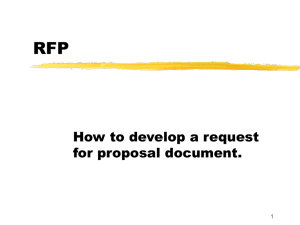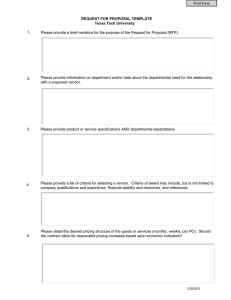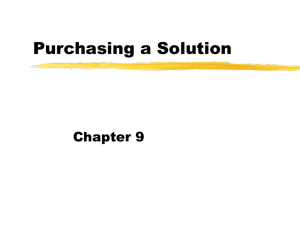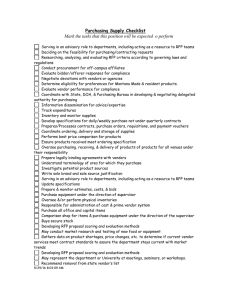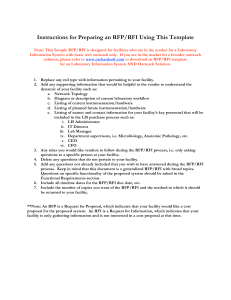Lecture Note 8
advertisement
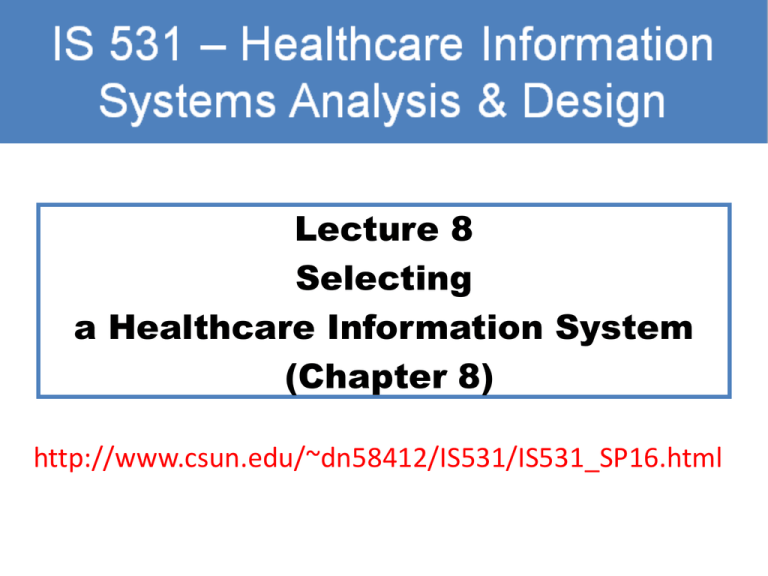
Lecture 8 Selecting a Healthcare Information System (Chapter 8) http://www.csun.edu/~dn58412/IS531/IS531_SP16.html Learning Objectives 1. System Selection Phase in System Development Life Cycle 2. Requirements Analysis for System Selection: Steering committee, issues to consider 3. Selection of System Vendor (RFI, RFP, RFQ, Gap Analysis) IS 531 : Lecture 8 2 Preliminary Considerations • Technology is the infrastructure of an organization: – The competitive advantages associated with HIS are contingent upon the technology, the degree to which technology meets the organization’s needs, the strength of the information services staff, and the speed and method by which the system is implemented. IS 531 : Lecture 8 3 Preliminary Considerations • The system is contextual: no “right” choice or “canned” solution for “all” facilities • It must be determined by a strategic goals / plan of a specific institution IS 531 : Lecture 8 4 Systems Development Life Cycle (SDLC) • Each system has a life time • SDLC is the process for the selection and implementation of an information system • Ongoing process of developing and maintaining an information system • Systems Development Process / Methodology : specific tasks, deliverables in process • Four main phases cover the life span of information systems IS 531 : Lecture 8 5 Systems Development Life Cycle (SDLC) 1. Analysis (needs/ requirements assessment) 2. Design (system selection) 3. Implementation 4. Maintenance / Support IS 531 : Lecture 8 6 SDLC IS 531 : Lecture 8 7 Requirements Assessment • Initiated by someone with a vision of the future and overseen by steering committee • Determine the gap between the current state and the overall needs in light of the organization’s strategic plan • Look at segments in the organization and current workflows for specific needs / improvements • SWOT Analysis for issues in financial, efficiency, quality IS 531 : Lecture 8 8 Steering Committee • Key success factor • Membership – Board members (ensure congruence with organizational strategic plan) – Representatives from all departments affected (to decrease possibility of missing potential problems) – Must include end users (patients ?) – Chair should be a member of administration to champion the project IS 531 : Lecture 8 9 Steering Committee Structure • Large enough to make a good decision but small enough to be effective and efficient • Multilevel committee – Upper level makes final decisions – Lower level /frontline makes recommendations • Need users with functional expertise, good communication, and computing background • May include consultants IS 531 : Lecture 8 10 Outside Consultants • May be used for any part of the selection or implementation processes • Effective use requires clear definition of the contractual relationship and expected outcomes • May be used to analyze all available information and make recommendations IS 531 : Lecture 8 11 Understanding the Current System • Must determine what information is used, who uses it, and how it is used • May use questionnaires, observation, and interviews • Must weigh strengths and weaknesses in light of organization’s needs IS 531 : Lecture 8 12 Determining System Requirements • User needs (with ranking weights) – Mandatory / functional : “musts” – Optional /non-functional : “wants / desirables” • Technical issues • Administrative / general issues • Functional / departmental issues IS 531 : Lecture 8 13 Technical Issues • Hardware and software needed for the desired level of system performance • Type of architecture (compatible with other system platforms) • Connectivity (network with other systems) • Response time • Availability: Operational vs. downtime • Test and training environments • Support for other Information Technologies IS 531 : Lecture 8 14 Administrative / General Issues • Compliance with regulatory and legal requirements on confidentiality, security and integrity (HIPAA) • Data standards and data exchange • Data storage (purging, restoring, backup data) • Report capabilities: predefined/automated vs. ad-hoc • Abilities to integrate with Heath Information Exchanges IS 531 : Lecture 8 15 Functional / Departmental Issues • • • • • • Registration Order entry/CPOE/ Results reporting Documentation/Billing Scheduling Medical records Accounting IS 531 : Lecture 8 16 System Selection • Survey on certified vendors with certain specialties • Trade shows and conferences • Publications – Professional organizations – Trade journals – User groups IS 531 : Lecture 8 17 Request for Information (RFI) • Brief document sent to vendors that states plans to purchase and install a system • Asks the vendor for a description of the system, its capabilities, and perhaps: – About the company – Number of installed sites – Technical capabilities – Updates IS 531 : Lecture 8 18 Request for Proposal (RFP) • Formal document sent to vendors to describe system requirements sought • Solicits proposals from vendors that describe their capabilities to meet the mandatory and optional requirements • Detailed and precise to facilitate accurate responses from vendors • Responses are used to narrow the choices IS 531 : Lecture 8 19 Template of RFP • Description of organization – – – – – Mission and goals Organizational structure Type of healthcare facilities Payer mix Volume statistics • System requirements (avoid specific configurations to open to effective alternatives) • Criteria for evaluation of responses • Deadline for submission IS 531 : Lecture 8 20 Analysis of RFP Responses • Considerations – Was it submitted by the deadline date? – Is it a professional effort? – Were the vendor representatives responsive? – Does the proposal address the RFP or is it a standard bid? IS 531 : Lecture 8 21 Request for Quote (RFQ) • Statement of need focusing upon pricing, service levels, and contract terms • Skips marketing hype often received in response to RFP IS 531 : Lecture 8 22 Site Visit • Visit many sites having installed the system under consideration • Ask the same set of questions at each for comparison purpose • Ask for a demonstration of the live system • Interview system users • Inspect system output • Contact other institutions have been using the system for comments and advises IS 531 : Lecture 8 23 Gap Analysis • Evaluate the system finalists • Gap Analysis: What needed and what vendor offered • Feasibility Analysis: Technical, Operational, Economic, Schedule, Risk (TOESR) • Economic analysis: Costs/benefits , return on investment … • Award contract to the winner and brief others IS 531 : Lecture 8 24 Contract Negotiation • After the system selection and recommendations negotiations are done through legal and purchasing representatives IS 531 : Lecture 8 25 Concluding Remarks • The system life cycle is ongoing (current system will reach its entropy someday !) • Each cycle of the system development process increase the body of organizational knowledge base for future choices. • Increased knowledge also help to shorten the selection process. IS 531 : Lecture 8 26 Additional Materials • Six steps to implement EHR http://www.healthit.gov/providersprofessionals/ehr-implementation-steps • Top EHR http://www.softwareadvice.com/medical/electr onic-medical-record-software-comparison/ IS 531 : Lecture 8 27
